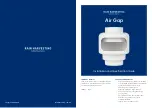
3-15
PROPULSION SYSTEM
The propulsion system is a closed-loop hydrostatic transmission. The variable volume
piston pump is driveline driven from the engine crank shaft. The pump can deliver up to
30 gpm (114 L/min) or 3,000 psi (207 bar) to the wheel drive motors. The flow from the
wheel drive motors returns directly to the pump inlet, not the reservoir. The built-in
charge pump maintains approximately 220 psi (15 bar) pressure to the intake side of the
piston pump whenever the engine is running. Excess flow from the 8 gpm (30 L/min)
charge pump combines with case drain flow and goes through the cooler and returns to
tank.
When the transmission control lever in the operator compartment is pushed forward, the
pump starts delivering oil to the wheel drive motors for forward travel. When the
transmission control lever is released, the pump blocks the flow and the wheel drive
motors stop. If this is done on level ground, the crane will stop and stand still. If this is
done on an incline, the crane will stop, but then creep down the incline, due to oil leaking
through the wheel drive motors. ALWAYS apply the parking brake when the crane is
stopped. When parking on a slope, also set the outriggers or place wheel chocks on the
downhill side of the wheels.
A positraction flow divider is located in the line between the pump and drive motors.
When a wheel is lifted off the ground, is on ice, or for any reason starts to spin, it will
momentarily take more oil than the wheel that has traction. When this happens, a spool
inside the positraction valve will shift and restrict the high flow to the spinning wheel,
forcing flow to the wheel with traction. If the unit stops moving, the engine speed will
have to be increased to resume travel.
The crane is equipped with an oil cooler that will allow it to operate properly when the
ambient temperature is over 100°F (38°C). An oil temperature gauge is provided just
ahead of the steering wheel. The sensor for this gauge is located in the return line to the
oil tank. If this gauge reads above 200°F (93°C), the unit should be shut down and the
reason for the excessive temperature located and corrected. The fins on the oil cooler
and engine radiator may be dirty and need cleaning.
For maneuvering in tight quarters the throttle should be set for low speed. For traveling
longer distances the throttle may be set to full speed. The vehicle speed is controlled by
the transmission lever.
A manual bypass valve is built into the piston pump. It appears like a shaft with a cross
hole in it on the side of the pump. If the machine cannot run under its own power, it can
be towed for very short distances at 3 mph (5 km/h) or less by turning the bypass valve
counterclockwise 4 turns. It must be turned back again as far as possible to run
normally.
CAUTION: The crane will roll freely down inclines with the bypass valve open. Keep the
valve closed except when towing and the crane is secured to the tow vehicle. An
operator must be in the crane to operate the brakes.
Summary of Contents for IC-20-1J
Page 6: ...1 2 DIMENSIONS AND ORIENTATION IC 20 1J Courtesy of Crane Market...
Page 7: ...1 3 TURNING DIMENSIONS Courtesy of Crane Market...
Page 25: ...2 11 Courtesy of Crane Market...
Page 26: ...2 12 Courtesy of Crane Market...
Page 36: ...Courtesy of Crane Market...
Page 44: ...3 8 IC 20 LUBRICATION CHART Courtesy of Crane Market...
Page 48: ...3 12 JIC SCHEMATIC Courtesy of Crane Market...
Page 50: ...3 14 STEERING SYSTEM Courtesy of Crane Market...
Page 52: ...3 16 IC 20 PROPULSION SYSTEM Courtesy of Crane Market...
Page 62: ...Courtesy of Crane Market...
Page 63: ...Powered by TCPDF www tcpdf org Courtesy of Crane Market...













































